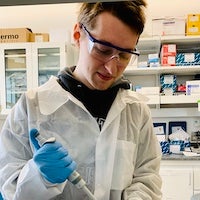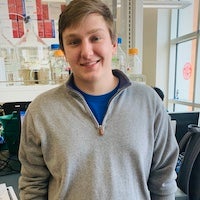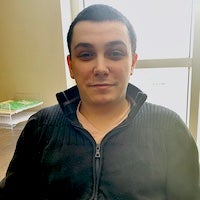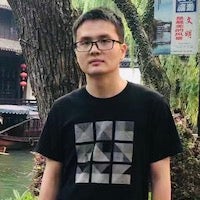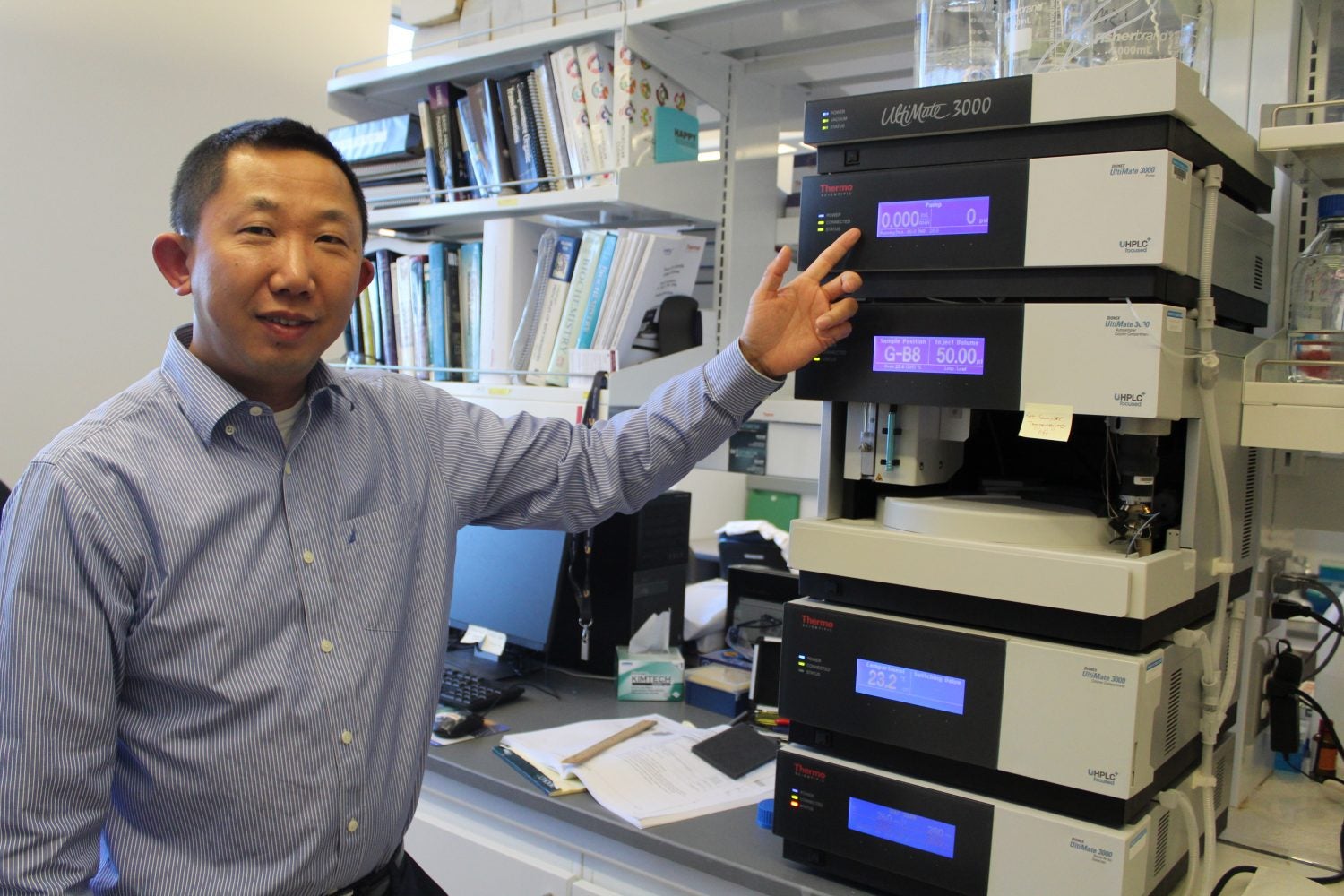Medical Organic Chemistry Laboratory
Located in Lab Module 410 on Level 4 of Avedisian Hall
Accessibility controls
Increase text contrast
Contrast: Standard
Reset text contrast
Contrast: High
Overview
Dr. Li’s research examines the formation of DNA lesions and subsequent mutations via chemistry and molecular biology techniques. The objective is to identify tumor development at early stage or even before its genesis by mapping out the mutational spectra of various carcinogens. Dr. Li and his team also work with specific molecular inhibitors such as Nitric Oxide and oncometabolites to certain DNA repair enzymes to understand their disruptive effects on cellular defending machineries.
Research
Mutational spectra of bulky DNA lesions (Supported by NIEHS as an R01)
Many environmental toxins damage DNA and cause diseases. The exposure of cells with DNA damaging agents results in the formation of a host of different DNA lesions, a subset of which can give rise to mutations. If one were to plot the frequency and type of mutation as a function of the position along a gene, a distribution is generated that is commonly referred to as a mutational spectrum. It is important for environmental scientists to provide insights into the evolutionary changes that foreshadow tumor development before overt clinical symptoms appear. This goal is crucial because some diseases, such as tumors, show few clinical symptoms until the disease has reached a late, usually deadly stage. Early onset genomic biomarkers might enable intervention to eliminate or curtail development of the disease. The biomarkers of a disease caused by a specific toxin can be obtained by studying the mutational spectra of DNA lesions generated from the toxin. At the conclusion of this project we will demonstrate the interaction between environmental toxins and the mutational spectra in human genome. These studies shall utilize in a combination of genetic, chemical, and spectroscopic tools to understand and manipulate biological systems at the molecular level.
Inhibitory effect of nitric oxide on DNA repair enzymes (Supported by NIEHS as an R15)
Nitric oxide (NO), a signaling molecule over produced in the inflammation process, has been reported to induce damage of cell membrane and lead to the accumulation of alkylated DNA adducts, such as 1,N6-ethenoadenine (eA), 3,N4-ethenocytosine (eC). In this project, we will study a new aspect of nitric oxide’s cellular role in inflammation and cancer: the inhibitory effect of NO on the AlkB family DNA repair enzymes. The AlkB proteins, a group of Fe(II)/α-ketoglutarate-dependent dioxygenases, have been established to repair DNA alkyl lesions by a direct reversal mechanism. Different homologs of AlkB exist in eukaryotic and prokaryotic species; nine such homologs exist in mammalian cells (ABH1-8 and FTO). In humans, ABH2 and ABH3 have been identified as DNA repair enzyme and constitute the most effective cellular defense against DNA adducts. In the preliminary study, we have shown that NO has strong inhibitory effect on AlkB, ABH2 and ABH3. Electron paramagnetic resonance (EPR) spectroscopic studies also showed NO binds to the Fe(II) ion in the catalytic center of AlkB, thus inhibiting the catalytic O2 binding and abolishing the repair activity of AlkB. The central hypothesis of this project is that NO delivers a “two-fold” damage to the cell by not only inducing alkyl DNA damages but also suppressing the AlkB family DNA repair enzymes. The focus of this project is to study the relationship between DNA repair and NO inhibition at molecular level both in vitro and in cell. The knowledge gained from those experiments will help us understand the molecular and cellular mechanisms of NO inhibition on DNA repair and provide insights for developing new strategy to prevent and overcome the cellular damage and tumorigenesis. Overall, these studies will characterize a role of nitric oxide in the pathological processes of inflammation and cancer. Once again, DNA damage is a primary initiator of many diseases and completion of the proposed studies will have direct relevance to human health.
Publications
Complete List of Peer-Reviewed Publications (*corresponding authorship)
- Ke Bian, James C. Delaney, Xianhao Zhou, Deyu Li# “Biological evaluation of DNA biomarkers in a chemically defined and site-specific manner” Toxics,
- Ke Bian*, Stefan A. P. Lenz*, Qi Tang, Fangyi Chen, Rui Qi, Marco Jost, Catherine L. Drennan, John M. Essigmann, Stacey D. Wetmore#, Deyu Li# “DNA repair enzymes ALKBH2, ALKBH3, and AlkB oxidize 5-methylcytosine to 5-hydroxymethylcytosine, 5-formylcytosine, and 5-carboxylcytosine” Nucleic Acids Research,
- Jessica L. Wojtaszek*, Nimrat Chatterjiee*, Javaria Najeeb*, Azucena Ramos, Minhee Lee, Ke Bian, Yaohua Xue, Deyu Li, Michael T. Hemann#, Jiyong Hong#, Graham C. Walker#, Pei Zhou# “Small molecule adjuvant disrupting Rev1-Polζ mediated mutagenic translesion synthesis improves chemotherapy” Cell, accepted.
- Fangyi Chen*, Qi Tang*, Hang Ma*, Ke Bian, Navindra Seeram, Deyu Li# “Hydrolyzable tannins are iron chelators that inhibit AlkB family DNA repair enzyme ALKBH2” Chemical Research in Toxicology, accepted.
- Ang Cai*, Ke Bian*, Fangyi Chen, Qi Tang, Deyu Li#, Bongsup Cho# “Probing the effect of bulky lesion-Induced replication fork conformational heterogeneity using 4-aminobyphenyl-modified DNA” Molecules, 2019, 24, 1566.
- Ke Bian*, Fangyi Chen*, Zachary T. Humulock*, Qi Tang, Deyu Li# “Copper inhibits the AlkB family DNA repair enzymes under Wilson’s disease condition” Chemical Research in Toxicology 2017, 30, 1794.
- Qi Tang*, Ang Cai*, Ke Bian, Fangyi Chen, Sravani Adusumalli, Alvin C. Bach II, Fatemeh Akhlaghi, Bongsup Cho, Deyu Li# “Characterization of byproducts from chemical syntheses of oligonucleotides containing 1-methyladenine and 3-methylcytosine” ACS Omega, 2017, 2, 8205.
- Fangyi Chen*, Ke Bian*, Qi Tang, Bogdan I. Fedeles, Vipender Singh, Zachary T. Humulock, John M. Essigmann, Deyu Li# “Oncometabolites D- and L-2-hydroxyglutarate inhibit the AlkB family DNA repair enzymes under physiological conditions” Chemical Research in Toxicology 2017, 30, 1102.
- Fangyi Chen*, Qi Tang*, Ke Bian, Zachary T. Humulock, Xuedong Yang, Marco Jost, Catherine L. Drennan, John M. Essigmann, Deyu Li# “The adaptive response enzyme AlkB preferentially repairs 1-methylguanine and 3-methylthymine adducts in double-stranded DNA” Chemical Research in Toxicology 2016, 29, 687.
- Bogdan I. Fedeles*, Vipender Singh*, James C. Delaney, Deyu Li#, John M. Essigmann# “The AlkB family of Fe(II)/α-Ketoglutarate-dependent dioxygenases: repairing nucleic acid alkylation damage and beyond” Journal of Biological Chemistry 2015, 290, 20734. (Invited for the seventh thematic series on Metals in Biology)
- Chunte S. Peng, Bogdan I. Fedeles, Vipender Singh, Deyu Li, Tiffany Amariuta, John M. Essigmann, Andrei Tokmakoff “2D IR spectroscopy of the anti-HIV agent KP1212 reveals protonated and neutral tautomers that influence pH-dependent mutagenicity” Proceedings of the National Academy of Sciences USA, 2015, 112, 3239.
- Shiou-chi Chang, Bogdan I. Fedeles, Jie Wu, James C. Delaney, Deyu Li, Linlin Zhao, Plamen P. Christov, Emily Yau, Vipender Singh, Marco Jost, Catherine L. Drennan, Lawrence J. Marnett, Carmelo J. Rizzo, Stuart S. Levine, F. Peter Guengerich, John M. Essigmann “Next-generation sequencing reveals the biological significance of the N2,3-ethenoguanine lesion in vivo” Nucleic Acids Research 2015, 43, 5489. (Highlighted as the Breakthrough paper of the journal and also by the MIT News on April 1, 2015)
- Bogdan I. Fedeles, Bret D. Freudenthal, Emily Yau, Vipender Singh, Shiou-chi Chang, Deyu Li, James C. Delaney, Samuel H. Wilson, John M. Essigmann “Intrinsic mutagenic properties of 5-chlorocytosine: A mechanistic connection between chronic inflammation and cancer” Proceedings of the National Academy of Sciences USA 2015, 112, E4571. (Highlighted by the MIT News on August 7, 2015)
- Deyu Li*, Bogdan I. Fedeles*, Vipender Singh*, Chunte S. Peng*, Katherine J. Silvestre, Jeffrey H. Simpson, Andrei Tokmakoff, John M. Essigmann “Tautomerism provides a molecular explanation for the mutagenic properties of the anti-HIV nucleoside analog 5-aza-5,6-dihydro-deoxycytidine” Proceedings of the National Academy of Sciences USA 2014, 111, E3252. (Highlighted by the MIT News on July 28, 2014)
- Vipender Singh*, Bogdan I. Fedeles*, Deyu Li*, James C. Delaney, Ivan D. Kozekov, Albena Kozekova, Lawrence J. Marnett, Carmelo J. Rizzo, John M. Essigmann “Mechanism of repair of acrolein- and malondialdehyde-derived exocyclic guanine adducts by the α-ketoglutarate/Fe(II) dioxygenase AlkB” Chemical Research in Toxicology 2014, 27, 1619.
- Nidhi Shrivastav, Bogdan I. Fedeles, Deyu Li, James C. Delaney, Lauren E. Frick, James J. Foti, Graham C. Walker, John M. Essigmann “A chemical genetics analysis of the roles of bypass polymerase DinB and DNA repair protein AlkB in processing N2-alkylguanine lesions in vivo” PLoS ONE 2014, 9, e94716.
- Vipender Singh, Chunte S. Peng, Deyu Li, Koyel Mitra, Katherine Silvestre, Andrei Tokmakoff, John M. Essigmann “Direct observation of tautomers of oxythiamine and their recognition by an RNA aptamer” ACS Chemical Biology, 2014, 9, 227.
- Deyu Li, Bogdan I. Fedeles, Nidhi Shrivastav, James C. Delaney, Xuedong Yang, Cintyu Wong, Catherine L. Drennan, John M. Essigmann “Removal of alkylation DNA adducts from N2-alkylguanine and N4-alkylcytosine by the adaptive response protein AlkB” Chemical Research in Toxicology 2013, 26, 1182. (Cover paper, August, 2013)
- Jingqing Zhang, Markita P. Landry, Paul W. Barone, Jong-Ho Kim, Shangchao Lin, Zachary W. Ulissi, Dahua Lin, Bin Mu, Ardemis A. Boghossian, Andrew J. Hilmer, Alina Rwei, Allison C. Hinckley, Sebastian Kruss, Mia A. Shandell, Nitish Nair, Steven Blake, Fatih Sen, Selda Sen, Robert G. Croy, Deyu Li, Kyungsuk Yum, Jin-Ho Ahn, Hong Jin, Daniel A. Heller, John M. Essigmann, Daniel Blankschtein, Michael S. Strano “Molecular recognition using nanotube-adsorbed polymer complexes” Nature Nanotechnology 2013, 8, 959.
- Deyu Li, James C. Delaney, Charlotte M. Page, Xuedong Yang, Alvin S. Chen, Cintyu Wong, Catherine L. Drennan, John M. Essigmann “Exocyclic carbons adjacent to the N6 of adenine are targets for oxidation by the Escherichia coli adaptive response protein AlkB” Journal of the American Chemical Society 2012, 134, 8896. (Highlighted by Chemical Research in Toxicology 2012, 25, 1286.)
- Gerald Kagan, Weibin Li, Deyu Li, Russell Hopson, Paul G. Williard “Characterization of dimeric chiral lithium amide structures derived from N-isopropyl-O-triisopropylsilyl valinol” Journal of the American Chemical Society 2011, 133, 6596.
- James I. Mullins, Laura Heath, James P. Hughes, Jessica Kicha, Sheila Styrchak, Kim Wong, Ushnal Rao, Alexis Hansen, Kevin S. Harris, Jean-Pierre Laurent, Deyu Li, Jeffrey H. Simpson, John M. Essigmann, Lawrence A. Loeb, Jeffrey Parkins “Mutations resulting from viral decay acceleration of HIV-1 genomes in a clinical population treated with the mutagenic nucleoside KP1461” PLoS ONE 2011, 6, e15135.
- Deyu Li, James C. Delaney, Charlotte M. Page, Alvin S. Chen, Cintyu Wong, Catherine L. Drennan, John M. Essigmann “Repair of DNA alkylation damage by the Escherichia coli adaptive response protein AlkB as studied by ESI-TOF mass spectrometry” Journal of Nucleic Acids 2010, 369434. (Invited submission for a special issue on “DNA Damage, Mutagenesis, and DNA Repair.”)
- Nidhi Shrivastav, Deyu Li, John M. Essigmann “Chemical biology of mutagenesis and DNA repair: cellular responses to DNA alkylation” Carcinogenesis 2010, 31, 59. (Invited submission for a special issue to celebrate the 30th anniversary of Carcinogenesis.)
- Deyu Li, Gerald Kagan, Russell Hopson, Paul G. Williard “Formula weight prediction by internal reference diffusion-ordered NMR spectroscopy (DOSY)” Journal of the American Chemical Society 2009, 131, 5627.
- Deyu Li, Ivan Keresztes, Russell Hopson, Paul G. Williard “Characterization of reactive intermediates by multinuclear diffusion-ordered NMR spectroscopy (DOSY)” Accounts of Chemical Research 2009, 42, 270.
- Deyu Li, Chengzao Sun, Jia Liu, Paul G. Williard “Characterization of a chiral enolate aggregate and observation of 6Li-1H scalar coupling” Journal of the American Chemical Society 2008, 130, 11726.
- Deyu Li, Chengzao Sun, Jia Liu, Russell Hopson, Weibin Li, Paul G. Williard “Aggregation studies of complexes containing a chiral lithium amide and n-butyllithium” Journal of Organic Chemistry 2008, 73, 2373.
- Jia Liu, Deyu Li, Chengzao Sun, Paul G. Williard “Analysis of an asymmetric addition with a 2:1 mixed lithium amide/n-butyllithium aggregate” Journal of Organic Chemistry 2008, 73, 4045.
- Deyu Li, Russell Hopson, Weibin Li, Jia Liu, Paul G. Williard “13C INEPT diffusion-ordered NMR spectroscopy (DOSY) with internal references” Organic Letters 2008, 10, 909.
- Lili Ma, Russell Hopson, Deyu Li, Yong Zhang, Paul G. Williard “Synthesis and structural characterization of the bis(diisopropylamino)boron enolate of tert-butyl methyl ketone” Organometallics 2007, 26, 5834.
- Jingguang Yu, Xiuzhen Luo, Lan Sun, Deyu Li, Wenhua Huang, Chunyu Liu “Chemical constituents from the seeds of Annona squamosa” Acta Pharmaceutica Sinica 2005, 40, 153.
- Wenhua Huang, Jingguang Yu, Lan Sun, Baolin Guo, Deji Basang, Deyu Li “Studies on chemical constituents of the seeds from Xanthium sibiricum” China Journal of Chinese Materia Medica 2005, 30, 1027.
- Lan Sun, Jiuxiang Zhu, Jingguang Yu, Donglei Yu, Deyu Li, Lidong Zhou “Chemical constituents from the seeds of Annona glabra (Annonaceae)” Acta Pharmaceutica Sinica 2003, 38, 32.
- Jingguang Yu, Tongmei Li, Lan Sun, Xiuzhen Luo, Wei Ding, Deyu Li “neo-Lignans and hemiterpenoid from the seeds of Artabostrys hexapetalus (Annonaceae)” Journal of Chinese Pharmaceutical Sciences 2002, 11,
- Deyu Li, Jingguang Yu, Jiuxiang Zhu, Donglei Yu, Xiuzhen Luo, Lan Sun, Shilin Yang “Annonaceous acetogenins of the seeds from Annona muricata” Journal of Asian natural products research 2001, 3, 267.
- Lan Sun, Jingguang Yu, Deyu Li, Jin Li, Xuedong Yang, Shilin Yang “Determination of Annonaceous acetogenins in annonaceae plants by HPLC” Acta Pharmaceutica Sinica 2001, 36, 683.
- Jingguang Yu, Tongmei Li, Lan Sun, Xiuzhen Luo, Wei Ding, Deyu Li “Studies on chemical constituents of the seeds from Atrabotrys hexapetalus (Annonaceae)” Acta Pharmaceutica Sinica 2001, 36, 281.
- Jiuxiang Zhu, Jingguang Yu, Xiuzhen Luo, Lan Sun, Deyu Li, Shilin Yang “Alkaloids from leaves of Goniothalamus cheliensis” Chinese Traditional and Herbal Drugs, 2000, 31, 813.
- Deyu Li, Jingguang Yu, Xiuzhen Luo, Lan Sun, Shilin Yang “Muricatenol, a linear acetogenin from Annona Muricata (Annonaceae)” Chinese Chemical Letters 2000, 11, 239.
- Kun Zou, Yuying Zhao, Deyu Li, Feng Xu, Junhua Zheng, Ruyi Zhang “Hydrophobic constituents from Albizia julibrissin” Journal of Beijing Medical University 1999, 31, 32.
- Kun Zou, Yuying Zhao, Bin Wang, Deyu Li, Shaoqing Cai, Ruyi Zhang “Structural identification of two diastereoisomeric saponins from Albizia Julibrissin” Chemical Journal of Chinese Universities, 1999, 20, 1877.
- Hong Liang, Yuying Zhao, Deyu Li, Li Tan, Jie Huang “Progress of chemical constituents and pharmacological activities of the plants in Bupleurum” World Phytomedicines 1999, 14, 191.




